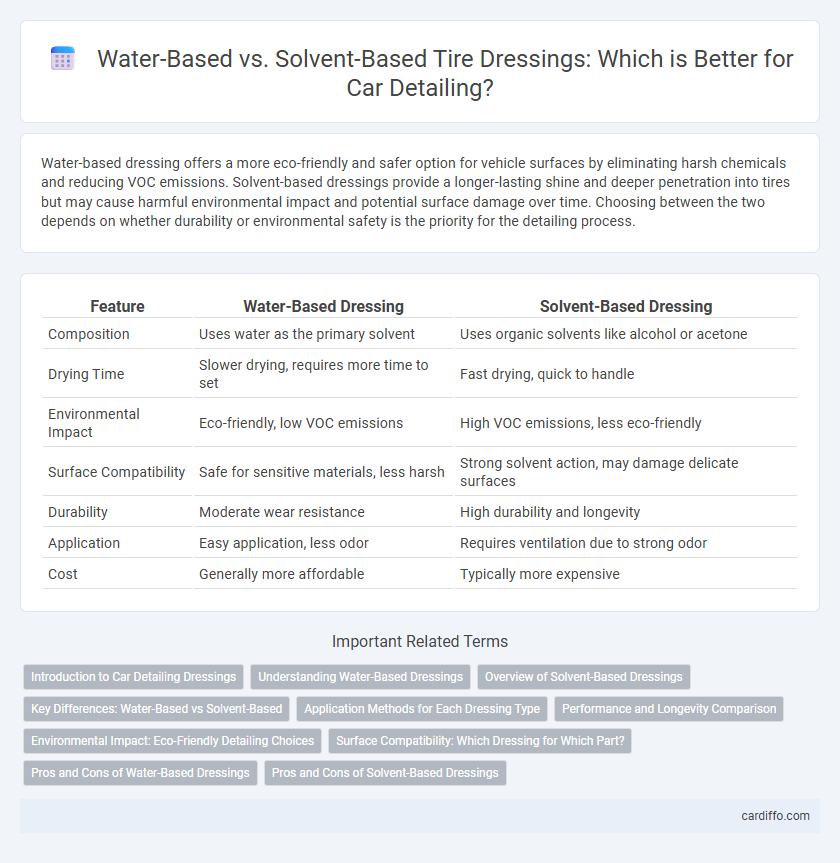Water-based dressing offers a more eco-friendly and safer option for vehicle surfaces by eliminating harsh chemicals and reducing VOC emissions. Solvent-based dressings provide a longer-lasting shine and deeper penetration into tires but may cause harmful environmental impact and potential surface damage over time. Choosing between the two depends on whether durability or environmental safety is the priority for the detailing process.
Table of Comparison
| Feature | Water-Based Dressing | Solvent-Based Dressing |
|---|---|---|
| Composition | Uses water as the primary solvent | Uses organic solvents like alcohol or acetone |
| Drying Time | Slower drying, requires more time to set | Fast drying, quick to handle |
| Environmental Impact | Eco-friendly, low VOC emissions | High VOC emissions, less eco-friendly |
| Surface Compatibility | Safe for sensitive materials, less harsh | Strong solvent action, may damage delicate surfaces |
| Durability | Moderate wear resistance | High durability and longevity |
| Application | Easy application, less odor | Requires ventilation due to strong odor |
| Cost | Generally more affordable | Typically more expensive |
Introduction to Car Detailing Dressings
Water-based car detailing dressings offer a safer, eco-friendly alternative that effectively restores tire and trim shine while resisting dirt and fading. Solvent-based dressings provide a longer-lasting, deeper gloss and enhanced protection against harsh weather conditions but may emit stronger odors and contain more volatile organic compounds (VOCs). Choosing between water-based and solvent-based formulations depends on desired finish, environmental impact, and application conditions for optimal vehicle care.
Understanding Water-Based Dressings
Water-based dressings offer eco-friendly advantages with significantly lower volatile organic compounds (VOCs) compared to solvent-based dressings, ensuring safer indoor air quality during application. These formulations provide effective lubrication and protection for automotive surfaces while drying faster and reducing odor, making them ideal for environmentally conscious detailing professionals. Their compatibility with various paint types and ease of cleanup using just water enhances overall efficiency without compromising finish quality.
Overview of Solvent-Based Dressings
Solvent-based dressings typically contain organic solvents that evaporate quickly, leaving behind a protective film that resists water and dirt. These dressings excel in providing a glossy finish and long-lasting protection on surfaces such as leather and vinyl. Their strong adhesion and durability make them ideal for heavy-duty applications, although they may emit stronger odors and require better ventilation during use.
Key Differences: Water-Based vs Solvent-Based
Water-based dressings use water as a primary solvent, offering low VOC emissions and faster drying times, making them environmentally friendly and safer for indoor use. Solvent-based dressings rely on organic solvents, providing superior durability and enhanced protection against harsh weather conditions, though they emit higher levels of volatile organic compounds. Key differences include environmental impact, drying time, and longevity, with water-based dressings favored for eco-conscious applications and solvent-based dressings chosen for heavy-duty protection.
Application Methods for Each Dressing Type
Water-based dressings require application with foam applicators or microfiber cloths to ensure even coverage and quick absorption, minimizing streaks and residue. Solvent-based dressings are often applied using spray bottles or directly on applicator pads, allowing for deeper penetration and enhanced protection on rubber and plastic surfaces. Proper surface preparation before application ensures optimal adhesion and long-lasting results for both dressing types.
Performance and Longevity Comparison
Water-based dressings offer excellent eco-friendly performance with fast drying times and minimal VOC emissions, making them ideal for regular vehicle maintenance. Solvent-based dressings provide superior longevity and deeper protection against harsh weather conditions and UV exposure, though they may emit stronger odors and require longer curing periods. Performance-wise, solvent-based options excel in durability, while water-based dressings prioritize ease of application and environmental safety.
Environmental Impact: Eco-Friendly Detailing Choices
Water-based dressings significantly reduce volatile organic compound (VOC) emissions compared to solvent-based dressings, making them a more environmentally responsible option for automotive detailing. Their biodegradable formulas minimize soil and water contamination risks, supporting eco-friendly maintenance practices. Opting for water-based products contributes to lower air pollution and aligns with sustainable detailing standards.
Surface Compatibility: Which Dressing for Which Part?
Water-based dressings are ideal for delicate surfaces such as plastics, rubber, and paint, providing a safe and non-reactive finish that prevents damage or discoloration. Solvent-based dressings excel on exterior trims, tires, and wheel wells due to their strong adhesion and long-lasting protection against UV rays and harsh environmental elements. Selecting the appropriate dressing based on surface material ensures optimal durability and appearance without compromising the integrity of vehicle components.
Pros and Cons of Water-Based Dressings
Water-based dressings offer eco-friendly advantages due to their low VOC content, reducing harmful emissions and improving indoor air quality during automotive detailing. They provide a natural, non-greasy finish that enhances surface protection and water repellency without leaving residue or attracting dust. However, water-based dressings may require more frequent application and can have reduced durability compared to solvent-based options under extreme environmental conditions.
Pros and Cons of Solvent-Based Dressings
Solvent-based dressings offer superior durability and water resistance, making them ideal for long-lasting protection of vehicle paint and trim. However, they tend to emit stronger odors and contain volatile organic compounds (VOCs), raising environmental and health concerns. These dressings also require careful application and proper ventilation to avoid surface damage and ensure safety.
Water-based dressing vs Solvent-based dressing Infographic

 cardiffo.com
cardiffo.com